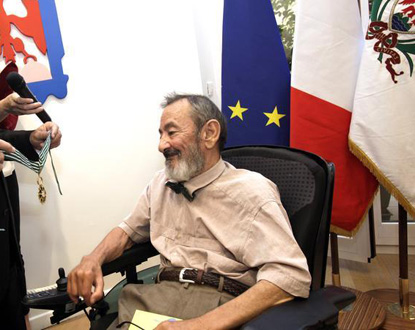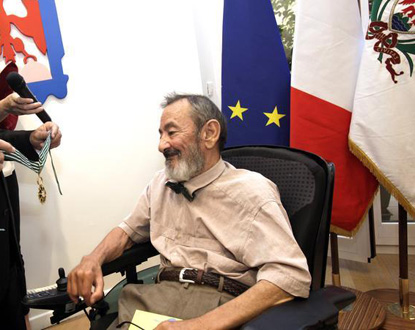The artist Claude Gilli received the insignia of Commander of Arts and Letters, which was presented to him by the Mayor of Nice, Christian Estrosi, at Galerie Ferrero during the opening of his exhibition.
 The most “pop” artist of the École de Nice, hails from a Nice family whose traces can be found in the city archives as early as the 15th century. The Gilli family includes a series of colorful characters. The grandfather, a barber, reportedly styled Modigliani’s hair at the beginning of the century. In 1955, he enrolled at the École des Arts Décoratifs of Nice and found himself alongside France Raysse, where he met her husband, Martial Raysse. It’s also there that he met Nicole Rondoni, a student in the Decoration-Volume section.
The most “pop” artist of the École de Nice, hails from a Nice family whose traces can be found in the city archives as early as the 15th century. The Gilli family includes a series of colorful characters. The grandfather, a barber, reportedly styled Modigliani’s hair at the beginning of the century. In 1955, he enrolled at the École des Arts Décoratifs of Nice and found himself alongside France Raysse, where he met her husband, Martial Raysse. It’s also there that he met Nicole Rondoni, a student in the Decoration-Volume section.
During the summer of 1957, another decisive meeting took place with Albert Chubac, who introduced him to modern art and a whole language of freedom where Claude Gilli would develop his own vocabulary.
The years 1959-1960 were a pivotal period in his work, the period of the Tirs and the OAS paintings. Of the latter, made of canvas, wire, and light bulbs, virtually nothing remains. They were destroyed along with the works created for the École des Arts Décoratifs during a symbolic auto-da-fé on December 31, 1962, on the beach of Saint-Laurent-du-Var.
The years 1963-1965 marked the era of cut and painted wooden works. The series of clouds, with soft and round shapes that Gilli cut with a small hand and metal saw, and then with the help of the electric saw given by Arman, who was saddened to see him struggle with inadequate tools on plywood panels.
In 1966, he presented his first pours, where pots of paint spilling a thick liquid, still in cut wood, create a spectacular wall-to-floor dynamic.
He abandoned color for a while in 1968, using transparent Plexiglas with a desire to explore non-color and reveal the poetry of transparency.
In 1969, a walk through the market on the cours Saleya caused a real shock: an overturned crate released a moving stream of snails searching for freedom. The random shapes of the moist imprints left on the ground pushed him to stage provocations: back in his studio, he subjected these gastropods to provocations. The living snail then became his preferred tool. He even dedicated to these snails, a monumental float as part of the 1994 Nice carnival.
In 1985, he created a monumental steel sculpture for the Palais des congrès of the City of Nice. This event led him to embark on a new path, that of creating steel sculptures.



